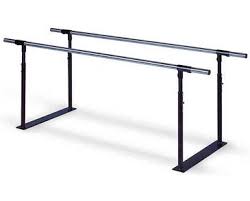เริ่มต้นการ ฝึกการทรงตัว ในราวคู่ขนาน (Parallel bars)
การ ฝึกการทรงตัว และการฝึกทางกายภาพบำบัดมีความสำคัญอย่างมากในผู้ป่วยโรคหลอดเลือดสมอง (Cerebrovascular disease, stroke) เนื่องจากผู้ป่วยโรคหลอดเลือดสมองจะมีความสามารถในการรักษาสมดุล (balance) ในการทรงตัวลดลงทั้งแบบนิ่ง (static balance) และขณะเคลื่อนไหว (dynamic balance) ซึ่งสัมพันธ์กับรูปแบบการยืน เดิน ที่ผิดปกติ
นอกจากนี้ยังพบความผิดปกติของความตึงตัวของกล้ามเนื้อแขนและขา จะมีการทำงานลดลงของระบบประสาทสั่งการ ทั้งกล้ามเนื้อแขนและขา ซึ่งเมื่อกล้ามเนื้อขาอ่อนแรง จะทำให้มีรูปแบบการทรงตัวที่ผิดปกติไป การให้การรักษาโดยการ ฝึกการทรงตัว ในผู้ป่วยโรคหลอดเลือดสมองเป็นสิ่งจำเป็นที่ต้องได้รับการฟื้นฟูอย่างต่อเนื่อง โปรแกรมการฝึกเดิน การฝึกความแข็งแรงของของกล้ามเนื้อขา และการฝึกการทรงตัว 1 ชั่วโมงต่อครั้ง 3 ครั้งต่อสัปดาห์ จะมีความสามารถในการทรงตัวและความสามารถในการประกอบกิจวัตรประจำวันมากขึ้น
อุปกรณ์ทางกายภาพบำบัด ราวคู่ขนาน หรือ Parallel bars เป็นเครื่องมือช่วยในการฟื้นฟูสมรรถภาพกล้ามเนื้อและข้อต่อให้มีความแข็งแรงขึ้น อุปกรณ์ฝึกยืน เดิน และการฝึกการทรงตัวทั้งแบบนิ่ง (static balance) และขณะเคลื่อนไหว (dynamic balance) การทำงานประสามสัมพันธ์กันของส่วนต่างๆ ของร่างกายให้ดีขึ้น สามารถทำให้มีความมั่นใจ และความสมดุลของการทรงตัว ซึ่งเหมาะสำหรับผู้ป่วยทุกคนที่เริ่มการฝึกยืน เดิน ทั้งผู้ป่วยหลังการผ่าตัด ผู้ป่วยกล้ามเนื้ออ่อนแรงครึ่งซีก ผู้ป่วยกำลังกล้ามเนื้อขาน้อย ผู้ป่วยที่มีการบาดเจ็บที่ไขสันหลัง เป็นต้น ข้อดีคือ เป็นอุปกรณ์ฝึกเริ่มต้น

สามารถรองรับน้ำหนักของผู้ป่วยได้ทั้งหมด มีความมั่นคงมากที่สุดในอุปกรณ์ช่วยเดิน เนื่องจากเป็นอุปกรณ์ที่ต้องติดตั้งอยู่กับที่ สามารถนำมาประยุกต์ใช้ที่บ้านของผู้ป่วยได้ ทำจากวัสดุที่หาได้ง่าย ข้อเสียคือ ไม่สามารถเคลื่อนย้ายอุปกรณ์ได้ ต้องใช้พื้นที่กว้างในการติดตั้งราวคู่ขนาน
ดังนั้นการเริ่มต้นการ ฝึกการทรงตัว ขณะยืน เดิน ร่วมกับการออกกำลังกายเพื่อเพิ่มความแข็งแรงของกำลังกล้ามเนื้อขา เป็นสิ่งสำคัญอย่างยิ่งที่ต้องได้รับการฝึกฝนฟื้นฟูทางกายภาพบำบัดควบคู่ไปอย่างต่อเนื่อง การฝึกการทรงตัวจะส่งผลให้ความสามารถในการรักษาสมดุล การควบคุมกล้ามเนื้อ มีความสามารถในการรับรู้ของข้อต่อขา รวมทั้งจุดศูนย์ถ่วงของร่างกาย (center of gravity) อยู่ในฐานรองรับ (base of support) มากขึ้น ในผู้ป่วยโรคหลอดเลือดสมองจะส่งผลให้ลดปัจจัยเสี่ยงในการล้มและเพิ่มความสามารถในการทรงตัวแบบนิ่ง (static balance) และขณะเคลื่อนไหว (dynamic balance)
อ้างอิง Schinkel-Ivy A, Inness EL, Mansfield A. Relationships between fear of falling, balance confidence, and control of balance, gait, and reactive stepping in individuals with sub-acute stroke. Gait & posture; 2016; 43:154-9
Begin practicing balancing on parallel bars.
Balance training and physical therapy training are very important in stroke patients.
(Cerebrovascular disease, stroke) because stroke patients have a decreased ability to maintain balance (static balance) and while moving (dynamic balance), which is related to standing and walking patterns.
Abnormalities In addition, abnormalities in the tightness of the muscles of the arms and legs were also found. There will be a decrease in the functioning of the motor nervous system. Both arm and leg muscles which when the leg muscles are weak It will cause abnormal balance patterns.
Providing treatment through balance training for stroke patients is essential and requires continuous rehabilitation. Walking training program Leg muscle strength training and balance training, 1 hour per session, 3 times per week.
There will be more ability to balance and the ability to carry out daily activities.
Physical therapy equipment, parallel bars, is a tool that helps in rehabilitating muscles and joints to make them stronger. Equipment for standing, walking, and balance training both while still (static balance) and while moving (dynamic balance).
The interplay of various parts. of the body for the better can make one have confidence and balance of balance It is suitable for all patients who begin training in standing and walking, including patients after surgery.
Patients with hemimuscular weakness The patient has little leg muscle strength. Patients with spinal cord injuries, etc. The advantage is that it is a beginner’s training device. Can support the weight of all patients It is the most stable of walking aids. Because it is a device that must be installed in place. Can be applied at the patient’s home.
Made from easily available materials. The disadvantage is that the equipment cannot be moved. A large space is required to install parallel rails.
Therefore, start practicing balance while standing and walking together with exercises to increase the strength of your leg muscles. It is very important to receive continuous physical therapy rehabilitation training. Balance training will result in the ability to maintain balance.
muscle control Has the ability to recognize leg joints. Including the center of gravity of the body (center of gravity) being more in the base of support (base of support) in stroke patients will result in reducing risk factors for falling and increasing the ability to balance still (static balance). and while moving (dynamic balance)